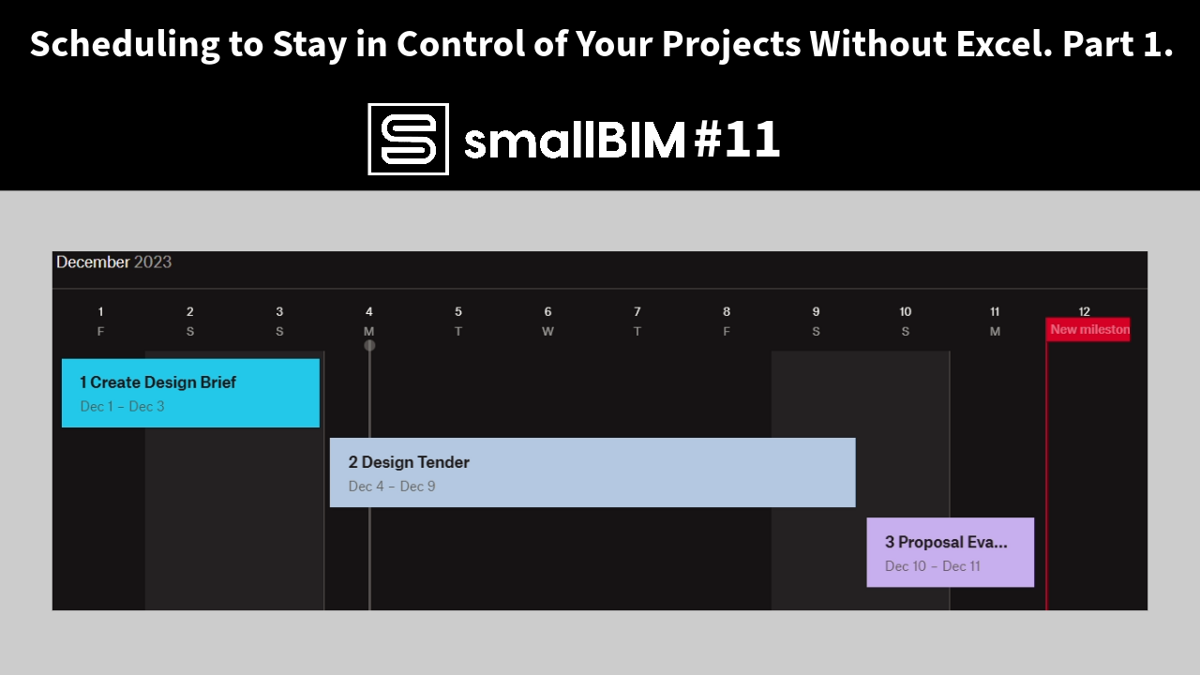Scheduling to Stay in Control of Your Projects Without Excel. Part 1.
December 5, 2023 at 7:00 am,
No comments
In this two-part blog post, I want to show you how to use two different free tools for creating, editing and monitoring schedules, and none of them is MS Excel. As you have probably heard, missing deadlines in construction is very common. So, by default, when planning anything, you should keep that in mind and have a good reserve. There are many reasons why deadlines are missed, but the most common is that project management (PM) is very poor, if non-existent at all. PM includes many activities, and at the core of them is also schedule/time management. One of the bad consequences of missed deadlines is increasing costs because you can't move into your building, but you are still paying for utilities, rent, taxes, or other expenses during the construction. For businesses, this is lost business altogether. From my experience working on small and big projects, schedules, if done at all, are made in Excel and, during the design/construction process, rarely updated. But projects are very dynamic—things change all the time. That is why being able to adjust schedules easily is so important. This allows figuring out the effects of the changes for the upcoming tasks and the overall deadline and trying to reduce those effects.

Scheduling Basics
There are several different methods used for scheduling, but the most common is the Waterfall method—a sequential, linear process of project management (PM). The visual representation of this method is a Gantt chart showing the following:
- Tasks to be accomplished
- Task duration and deadlines (milestones)
- Task dependencies—what tasks can't be done without finishing previous ones. For example, you are not able to design MEP without architectural layouts.

Why Excel is Not Good for Scheduling?
While used most commonly in small and even big construction projects, it is not a proper scheduling tool because the schedules are usually static, meaning they are created once and then rarely updated during the project. As I wrote before, many things change during any project. There are many good free and paid scheduling tools available on the web, but I will share my experience with two of them.
Free Dynamic Scheduling with Dropbox Paper
As the name suggests, Dropbox Paper is part of the Dropbox file-sharing platform. Paper is basically a document creation tool similar to Google Docs, but simpler, yet very intuitive and designed for collaboration. I have used Paper for many activities, such as writing ideas, creating collaborative documents, sharing briefs, etc. A while ago, a new feature called 'Timeline' was introduced, which is a very simple scheduling tool.
Paper Timeline - How to Create a Schedule
After creating a new Paper document, click anywhere in the blank space and a pop up will appear with different tools. Click on the Timeline button.

Create a new task by clicking on the schedule. You can either drag the task to set the duration or enter it manually. Name the task and the change color if you like.

If you click right under a date, you can add a milestone marker.
Continue adding as many tasks as you need. Tip: number the tasks and if necessary write the explanations of those numbers separately, because if you are sharing an image of the schedule, then some names might not be fully readable.
It is possible to zoom in/out by adjusting what period of time the schedule is displaying in the top right corner.

What Makes Paper a Good Scheduling Tool?
First of all, you can mark which tasks are done by clicking on the task and then checking it off. Then, you are able to make adjustments if needed: drag and make the duration of the task longer, move the other tasks, etc. And one more powerful feature of Paper is the ability to share the schedule either in view only mode or by inviting collaborators e.g. your team.

Conclusion
Dropbox Paper Timelines is a very simple tool, and I have used it for different projects, but usually those that do not have too many tasks, which can make managing time-consuming. So, whether you are preparing for a party or planning your flat renovation, this tool can help you a lot to think about how to fit everything into the desired timeframe and make quick adjustments during the project execution.
In part 2 I explain a free tool I use for more complex scheduling.
